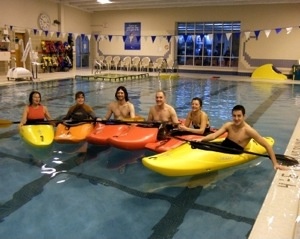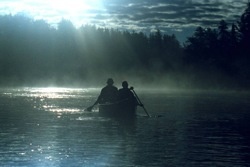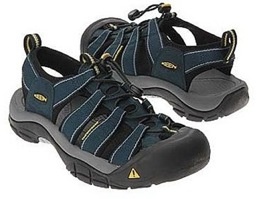Blog on a Log
Thursday, December 30, 2010
5 Unusual Items to Pack for a Summer Festival

The Winnipeg Folk Festival takes place next week, and I (like so many Winnipegers) am pulling out gear, packing my bags, and getting ready for an amazing extended weekend of music and fun. The WFF is one of the largest festivals of its kind in North America, but it's just one of many varied summer festivals taking place this season all over the Northern hemisphere.
As I compiled my packing list, I started to think: regardless of whether your festival of choice features music, paddling, or celebrations of headless chicken, some of the best summer festival must-haves are items attendees might not think of. Sure, if you're camping, pack a tent and sleeping bag. Sunscreen's important if it's sunny and rain gear if it's damp, but here are a few more items you might not have thought of that could vastly improve your festival experience:
1. Re-usable water bottle - The Winnipeg Folk Festival has readily accessible water spouts spread throughout the festival grounds for attendees to fill their water bottles or mugs and stay hydrated. Before you head out to any festival, check if they offer similar services. If not, bring along a large container of water to leave in your campsite or car and fill your bottle from throughout the day. Drinks tend to be in high demand in the summer heat, and consequently quite expensive. A simple water bottle can do wonders to minimize both your ecological and financial costs.
2. Headlamp - especially if you're camping, the convenience of a headlamp is going to hugely outweigh any silliness you may feel in wearing one. See toe-stubbing tree roots before feet find them, trek to the outhouse late at night, or find the socks in your bag before you lose your spot at the night's best concert. Much more convenient than a flashlight, a headlamp will keep your hands free for carrying items. Most festival grounds have little to no artificial lights, and even the summer sun does set eventually.
3. Buff - It really speaks to the Buff's versatility that this product keeps finding its way onto so many of my blog posts. So here we go again - besides being the perfect gift for father's day and a great travelling companion, a Buff is also great for festival-goers. The Buff guards against "the cold, sun, wind or dust in rapidly changing outdoor situations" - ‘rapidly changing outdoor situations'.... sure sounds like a festival to me. During the day soak your Buff in water to stay cool or use it to protect skin from the sun. In the cooler evenings you're ready with a scarf or toque. As a headband or hair tie it can help you through the fourth day without a shower, and if any group was ever going to support you rocking the pirate bandanna look it would be your fellow festival pals.
4. Wet Wipes - Speaking of the lack of showers, the most die-hard festivalers will tell you the best way to feel half-human after days on site is a wash with a few wet wipes. An unscented baby wipe is an inexpensive yet effective way to keep clean. If you carry a package around you'll be surprised how often they come in handy - cleaning hands after a messy meal, removing face paint so it doesn't stain your pillow, or if the porta-potties run out of toilet paper (a far too common crisis).
5. A festival chair - Some festivals don't allow chairs at all, but many allow seats of a certain height, or at least have a designated chair area. A trap or blanket is a must-have for all festival attendees, but small lightweight chair can feel like heaven after a few days. If your festival of choice has chair height restrictions, check out our Folk Fest chairs in store, which meet the under-2-feet requirements for the Winnipeg Folk Festival, and should do you well at most summer festivals.
Looking to experience a festival this summer? Check out this list of outdoor events and festivals in Canada
Photo via kevindooley
Thursday, December 30, 2010
What Good is a Pool?
We Canadians are lucky to have some of the most beautiful paddling locations in the world. We suffer a trade-off, however - no amount of paddle wear or dry clothes can change the fact that for several months of the year our outdoor waterways are un-paddleable.
What's a paddle enthusiast to do? Mope all day? Watch adventure videos? Go kayaking in the snow? For those who can't survive without their paddling fix--and beginners who want to get started but aren't sure how--pool sessions are the best way to keep limber and learn new skills while waiting for next spring.

But I'm just a beginner - I've never paddled before
Perfect! There are lots of beginner sessions where you can get a general introduction to kayaking or pick up a specific skill. In fact, some beginners find the familiarity and enclosed space of a pool to be comforting when first learning. Remember: beginner's classes are made up of other people just like you, and run by instructors who will take things one step at a time to build the skill set you need to feel comfortable on the water.
I've been paddling for years - I don't need to learn the basics
There are sessions for you too! Why not try an advanced rolling course to tighten your roll, or an introduction to freestyle techniques? Paddling on a regular basis this winter, regardless of which clinics or open sessions you choose to attend, will help keep your skills in top-form for next season. Pool sessions also offer an opportunity to tighten those basic skills that may get neglected during regular paddling outings--which can make a huge difference to your more complex paddling excursions.
What skills will I learn?
This depends entirely on the course you choose to attend, but sessions focus on a wide variety of skills, including:
- Rolling (basics and advanced)
- Flatwater kayaking
- Partner / Tandem rescues
- Bracing
- Freestyling
and more!
No matter your skill level or how frightful the weather outside may be, there's no need to go through the next six months without ever touching a paddle. Check out the wide range of pool sessions taking place this fall and winter for your chance to be on the water year-round.
Planning to hit the pool this winter? Have stories of past sessions? Tell us about it on Facebook or Twitter. Subscribe to our blog RSS feed for future updates, videos and deals.
Thursday, December 30, 2010
Gifts for Every Adventurer (and Budget!)
As usual, year-end has snuck up on me. With the holidays just around the corner, we're all struggling to find the perfect gift for everyone on our 'nice' list. Never fear - we've got gift ideas for every type of outdoors enthusiast and every price range. Try a budget-friendly stocking stuffer to show you're thinking of them, a middle-minded gift for somebody special, or, if you're really feeling generous, a budget-busting idea sure to maximize gift recipient enjoyment - and minimize bank accounts!
 The Bird Watcher
The Bird Watcher
For those who love all that's feathered.
Stocking-Stuffer: If you want to bring the birds to you there's no better way than a simple bird feeder. At home or at the cabin, a cheery locale will mean endless viewing opportunities for the aviary lover on your list.
Middle-Minded: When you're trying to catch a glimpse of that elusive feathered friend, it pays to give your eyes a little boost. If someone on your list considers hard-to-find sightings a mater of pride, why not treat them to a pair of quality eye-enhancers like the Bushnell Powerviews.
Budget-Blowing: for the ultimate bird watching experience, treat your gift-ee to some rare sightings from their own easy chair. The incredibly rare Blue Mutation Yellow-naped Amazon Parrot retails for approximately $300,000. Then again, you can "watch" it every day. So real, cost-per-viewing figure is way lower. It's practically earning you money.
 The Directionally Challenged
The Directionally Challenged
If getting lost is more of a inevitability than possibility, these gifts might be just the thing:
Stocking-Stuffer: If you don't know where you're at, at least know which way is which with a compass. Simple and reliable, sometimes the old ways really are the best. (Silva Polaris)
Middle-Minded: The new DeLorme PN-60w with SPOT messenger has won more awards than you can shake a stick at. In fact, there'll be no need for stick-shaking when you're using this handy unit, with quick and precise GPS positioning, Topo American software for full-featured travel planning and routing, customized maps, and the ability to send SPOT messages and track location worldwide. Everything but the kitchen sink all in the palm of your hand.
Budget-Blowing: For the truly navigation-incapable, you could always take matters out of their hands entirely. Hiring a personal chaufer to ferry them around will run you around $500-$1000 a day. At least if they get lost, they'll have some company.
 The Canoe Lover
The Canoe Lover
Winter's hard for paddle enthusiasts. Help tide them through with a canoe-themed gift or two.
Stocking-Stuffer: wanted to get them a canoe, but weren't sure how to get it under the tree? Santa feels your pain - let them know your heart was in the right place with this fun tree ornament
Middle-Minded: for those who like to make paddling a family affair, why not gift a canoe drop seat? It's a great way to turn a two-seat canoe into a comfortable paddle for three, or to make a regular canoe fit for solo paddling. Anyone who's every tried to paddle from the duffer's seat knows this unassuming bit of metal and foam is actually pure luxury.
Budget-Blowing: The world's most expensive canoe is..... not even water worthy? It's true: the dubious achievement of 'most money paid for a canoe' seems to belong to the 1991 painting "White Canoe" by artist Peter Doig. The artwork fetched an astonishing $10 Million at auction. On the plus side, it is more portable than a full-sized boat, so the portages should be easy.
 The Traveler Extraordinaire
The Traveler Extraordinaire
Have they got feet that just never stop itching? Try these gifts - if they're home for the holidays to get them!
Stocking-Stuffer: Gear security should always be travel #1. You can't protect against everything, but show your travel-lover you've got their safety in mind with a valuables travel pouch.
Middle-Minded: When you're living out of your backpack, there's nothing more luxurious than some padding and a support strap or two. Treat your vagabond to a brand new bag with the latest in comfort and function. It might be your only chance hear the words "Wow! a rain guard!" spoken with no trace of sarcasm.
Budget-Blowing: A RTW ("Round the World") ticket will run you around $4000-$5000, but think of all the possibilities! It'd certainly be a gift to remember.... just request that as the giver, you're exempt from sitting through the 20,000-photo sideshow upon their return.
 The Dog Lover
The Dog Lover
What do you get "man's best friend"'s best friend?
Stocking-Stuffer: For the canine-walker, there is no greater frustration then to be found without a plastic bag when needed. Solve their number-2 woes and encourage eco-friendly disposal with the Silverfoot Poo Pouch. 100% degradable bags will be right at their fingertips with this pouch small enough to clip on to a leash or backpack.
Middle-Minded: If your dog's used to coming with, it's about time their carried their own weight! A dog backpack lets your pooch help with the load without interfering with the dog's stride or comfort. Built to withstand the extreme punishment of a dog in the bush, in sizes to accommodate a range of canines.
Budget-Blowing: For the ultimate in doggy luxury, their pooch can lounge in style with a luxury dog kennel; 250,000 lbs will get you a sound system, temperature controlled beds, and a canine retinal scanner so Fido doesn't bring home any unexpected pals. Because with a crib this ballin, he's going to want to host all the block parties.
 The Party Animal
The Party Animal
For those who really know how to have a good time...
Stocking-Stuffer: The Can-Panion is a great multi-use accessory, providing hands-free drink holding in your canoe, kayak, fishing boat, ATV or campfire chair. Wherever their adventures take them, at least their beverage will be close-by.
Middle-Minded: For those who like to take the party with them, the GSI adventure travel bar makes a great companion. Take a little spirit on the trail with this 7-piece kit featuring 2 flasks, 2 acrylic tumblers, a cocktail shaker, and a cutting board all in a handy carrying case.
Budget-blowing: At $225,000 a bottle, it's probably fair to call the Ley .925 Platinum & White Gold tequila the most expensive hangover money can buy. On the plus side, after the liquor's gone the case should fetch more than your standard 10 cent bottle return.
 The Trail Chef
The Trail Chef
It takes a special kind of talent to turn dehydrated foodstuffs into gourmet meals - show your back-country chef a little loving
Stocking-Stuffer: The holidays are a time of decadence and gluttony - it's unlikely you'll find spam or plain oatmeal among your Christmas dinner. Remind them of simpler times with a fun trail breakfast tree ornament!
Middle-Minded: Trail cooking takes a little pizazz, a whole lot of lovin' and just the right gear. Make them feel like they've got the comforts of a home kitchen with a streamlined and effective cookset. New developments have made cook-sets lighter and more durable than ever, with great versatility and small pack-size. This 'aint your parent's camping pot!
Budget-Blowing: Sometimes there's no nicer gift than to let someone take it easy for a while. Try hiring a personal chef for your next adventure. A weeks' worth of meals will run you around $500, plus groceries - though getting them to agree to come camping in the first place will probably run you extra.
Still not sure what to get your outdoor adventurer? Subscribe to the Blog on a Log so you don't miss our next post on great gifts under $20!
Photos via creative commons on Flickr. Dog: jpctalbot, beer: viZZZual.com, birds: Todd Barnard, map users v1ctor, travelers: tjk, trail cook: OakleyOriginals
Thursday, December 30, 2010
Let it Snow, Let it Snow, Let us Bike!
I know, I know. It's December, it's cold, it's snowy - biking may be the last thing on your mind. Yet in recent weeks I've seen many brave souls facing the cold on two wheels around our city. I always feel an urge to cheer them on; winter biking is far too uncommon and should be encouraged. There's no need to throw away all the environmental, physical and mental benefits biking brings as soon as the snow hits the ground--a few adjustments are all you need to make cycling a year-round activity.
 Know Your Roads
Know Your Roads
Snowbanks can decrease road area. If your route does not have designated bike paths or these paths have not been cleared, you may be sharing even less road space than usual with the cars out there. Remain alert and aware of the vehicles around you.
You may have to wait until roads have been plowed to ride safely. Deeply-rutted routes can give you few options but to ride directly in line with vehicles, making it difficult for drivers to pass you and increasing the chance of a collision. Check the state of the roads before each ride. If they look a mess you can opt for the bus and try again tomorrow, but generally if you can drive a road you can probably bike it.
Adapt Your Riding
Give yourself extra time--up to twice as long--to reach your destination. A slower pace means more control and ability to react on unforgiving roads.
Increase your stopping distance. Roads are more likely to be icy at crossroads and lights, and snow on your wheels or pads can further hinder braking. Using the back break instead of the front can provide better control in icy conditions and lessen the chance of skidding. Occasionally pumping the brakes while riding can help prevent icy buildup.
Beware of turns. Your warm-weather lean may cause skidding on icy roads--remain as upright as possible and take turns slowly.
Dress Appropriately
Proper layering is crucial than when participating in winter exercise. A well-selected base, mid- and outer-layer will keep out the chill without overheating. Many first-time cold weather bikers dress too warmly; once they get moving the exertion causes them to overheat. A good rule of thumb is that if you are a comfortable temperature when not biking, you will be too hot on the road.
Not sure how to set up a layering system? Check out our Layering 101 video:
Your extremities have the potential to get dangerously chilled while biking. Be sure to wear warm, moisture-wicking socks with shoe covers or booties. A hat and facemask or full balaclava are essential, and may necessitate a larger helmet.
Bicycle helmets are vented to keep you cool. For the winter season you may want to cover these vents in tape, or move to a full snowboarding or snowmobiling helmet, both of which are designed to keep your head warm.
Your hands suffer from limited movement and increased windchill when riding. Do not neglect high-quaity gloves and/or mittens. You may wish to invest in a set of pogies, which protect your hands while still allowing bare-fingered access to brakes, and can be used in addition to a set of gloves for extra warmth on very cold days.
If you are new to winter sports in general remember that lack of heat does not mean lack of sun. Glare off snow can be distracting and damaging to the eyes. Be sure to wear a pair of sunglasses or (even better) a set of skiing/snowboarding goggles, which also protect against blowing snow on windy days.
Choose and Protect Your Bike
If you usually use a more lightweight road bike for summer riding, consider buying a cheap "beater" bicycle for winter riding. The small investment will be worth it if it protects your expensive bike from undue wear.
Mountain biking-style bikes with wider, heavily tractioned tires do well on winter roads. Special studded tires are available, but will be overkill for most city biking. Reduce your tire pressure--though you'll travel slower, traction will be increased.
It can be a good idea to bring your bike inside, but only if it will have the chance to dry off completely, as a damp bike will re-freeze during riding. If your bike has been stored indoors, allow it time to cool down outside before riding - the warm metal can increase slush build-up, which will subsequently freeze.
 Clean and lubricate your bike often with a low-temperature grease. Winter slush, salt and sand can wear away at your bike very quickly; for extra protection consider adding an enclosing case around your chain.
Clean and lubricate your bike often with a low-temperature grease. Winter slush, salt and sand can wear away at your bike very quickly; for extra protection consider adding an enclosing case around your chain.
Accessories are a Biker's Best Friend
Remember that it will be dark later in the mornings and earlier in the evenings during the winter months. Make sure your bike is equipped with lights and wear reflective clothing to help drivers spot you on the road. Winter bikers are somewhat unusual, and car drivers may not be watching--or be distracted by their own winter driving. Adding extra lights and reflectors is a good precaution.
As with wet weather riding, front and back fenders can help keep slush and snow on the road where it belongs.
If you lock up your bike outside lock de-icer makes a good addition to your bag. The last thing you want is a bike you can't access.
Cold-weather excursion still dehydrates. Make sure you bring along liquids. If temperatures are too cold for a water bottle, try a camel-back system worn under the clothes.
Cold weather biking is a great way to stay in shape and get outdoors during the winter months. Join the brave few on the roads this season--at the very least you'll have great one-up-manship stories for your company Christmas party.
Photos via flickr. Bicycles: Ragnar Jensen, winter cyclist: Marc van Woudenberg
Thursday, December 30, 2010
Best Foot Forward - How You Can Travel With One Pair of Shoes
Last week I got talking about multifunction as a space-saving technique. Perhaps nowhere is this more crucial than when living out of a backpack (whether during travel or on trail).
Shoes. Shoes were the bane of my existence on my first backpacking trip. Sure, most pairs don't weigh a lot, but the space they take up is atrocious. On my first trip I carried five - count ‘em, five - pairs of shoes, and the extras I wasn't wearing took up at least a third of my pack.
What were these pedal offenders? I traveled with runners, crocs, athletic sandals, flip-flops and flats. FIVE PAIRS of shoes. Atrocious! I figured I had to cut that down for all future trips.... but how? Each pair was brought for a function, and I wore them all, at one time or another. What gets cut, and why?
There is a way you can backpack with only one pair of shoes. Yes, you heard me: ONE PAIR. The pair you wear on the plane with you will be the only pair you need. Your pack can remain completely shoe-free. I'll just let you imagine that for a moment before I explain. Done? Great.
I got caught up on that first trip because I needed shoes for multiple temperatures, weather conditions and situations. As I said in last week's blog, even the best of us have trouble packing light when a trip is filled with variety. The multiple shoes I carried responded to multiple situations:
- Cold weather walking - runners
- Warm weather walking - athletic sandals
- Wet weather walking - crocs (because they don't retain water)
- Hostel showers and beaches - flip-flops
One pair is missing from that list: the flats. That's cause I bought them in Paris part way through, and you know what? Every trip to Paris deserves a pair of shoes. Lets just leave it at that. But beyond my French shopping splurge, there's not a lot going on there that doesn't make sense - which means that the problem isn't in the logic, it's in not finding the right multifunctional footwear to cover my bases.
Want to be a one-pair traveler? Here's what you're going to do: you're going to buy a pair of Keen shoes. Something along the lines of
these or these.
Now. Sit back and watch the magic begin:
When you travel you're going to have warm days, and you're going to have cold days. This is pretty much a given for all but the most extreme climes, so you're going to need footwear that can keep you warm or cool. A pair of open-sided shoes such as the Keens shown above scores well in the "keeping cool" department, but it also takes very little to keep your tootsies warm on colder days. A good pair of wool socks (smartwool is a great brand, and we carry lots of options in store) can be layered with your shoes to keep you warm in any situation you'd face on your average backpacking adventure.
So we've narrowed four shoes to three already by choosing a shoe and sock combination to take us from warm to cold weather without a problem. Next we have to consider what to wear when it's wet. Depending on where in the world you travel ("from Kiev to Carolina") rain can be an almost constant companion. When the streets are damp, the last thing you want to be wearing is a full runner. The fabric will soak up and retain water, and before you know it you'll be chilled to the bone. It's incredibly hard to stay warm if your feet get cold, and if you're not careful you may find yourself heading back to the hostel before you've really gotten out the door.
No one has the pack space for a pair of rubber boots, so backpackers have long been forced to come up with alternative options when the weather turns wet. I've seen travelers trudging around with plastic bags taped over their feet, but I far prefer to simply stick with a shoe made of materials that dry quickly. It's hard to stop your feet from getting wet, but the right pair of shoes can at least minimize the time you have to spend feeling damp. When you step out of the rain into a pub or museum you'll find yourself chipper and dry within minutes instead of squishy and damp for hours. And if open-sided shoes sound too chilly for your tastes, that same pair of wool socks will keep your feet warm in the rain, since wool insulates even when wet.
From four down to two - we're doing well, cutting our shoe space in half. All that remains is a pair of flip-flops for the hostel shower or the beach. Now, myself, considering how little space a pair of flip flops takes in a pack, I might take them along for pure convenience sake, but if you're really pushing for less-is-more, the Keens will take you through these situations too. The quick-dry material means stepping in and out of the shower poses no problem, and they'd do you just fine for a day at the beach - a lot better than a flip-flop, truth be told, considering their stability, support and infamous toe protection.
Beyond all this functionality, Keens are just a great pair of shoes. Their Women's ‘Voyageur' style was voted "best hiking shoe" by fitness magazine and Outside Buyer's Guide called them "tough as beef jerky." An acquaintance who's had multiple knee surgeries and works on her feet all day claims they're the only shoes she can wear. Come in and try a pair on, and I think you'll find they're so comfortable you'd be happy to wear them every day.
So the answer to the backpacker shoe woes? A good pair of Keens. We've got a variety of styles and colours in store for you to check out, and we're always happy to special-order if you prefer a style we don't regularly stock. Paired with a set of good wool socks, they'll take you from warm to cold, wet to dry, pavement to beach to pub to showers. What more could a backpacker need? (except maybe a Parisian splurge or two)
B
















